
Clon Macnoise on the River Shannon
There was an other worldly presence here, and I felt goosebumps rise on my arms.
It was hard to believe I was in Ireland. This was a trip I’d dreamed of for years and now I could hardly close my eyes for fear of missing something. As I became acquainted with the Irish countryside, sugar-coated images of thatched cottages and leprechauns fled before the splendor of the real thing. Here, velvet blue skies flanked rolling green hills, ancient stone buildings hovered on every horizon, and age-old rock walls snaked across the fields.
I had expected, the scenery in Ireland to be fascinating, but was pleasantly surprised to learn the same could be said of its history. Especially in places like St. Ciaran’s Monastery at Clonmacnoise.
This was an Unusual Place
Clonmacnoise is in Southern Ireland, in County Offaly, and though it’s a little out of the way, it’s well worth the extra effort. As we passed through the front gates it was immediately clear this was an unusual place. There was an other-worldly presence here. Something almost palpable hung like a mist in the air, and I felt goose bumps rise on my arms.
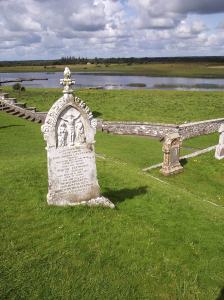 You’d be hard put to find a prettier setting. To my left, the River Shannon sparkled in the afternoon sun and on the right, crumbling stone churches and tilting headstones sat, patiently waiting for the end of time. I was drawn to the cemetery as I always am at such places and as I approached, my initial sense of unease returned. I warily eyed the names on the grave markers, half-convinced by now that I’d stumbled onto the burial place of a long-lost ancestor. Perhaps I’d been recognized by a restless spirit and had more company on this walk than I cared to think about.
You’d be hard put to find a prettier setting. To my left, the River Shannon sparkled in the afternoon sun and on the right, crumbling stone churches and tilting headstones sat, patiently waiting for the end of time. I was drawn to the cemetery as I always am at such places and as I approached, my initial sense of unease returned. I warily eyed the names on the grave markers, half-convinced by now that I’d stumbled onto the burial place of a long-lost ancestor. Perhaps I’d been recognized by a restless spirit and had more company on this walk than I cared to think about.
But the more I learned about this former monastery, the more I understood the atmosphere here. Perhaps it was nothing more than a sense of unfinished business since this was a place where many lives ended before their time.
The Picture of Peace and Harmony
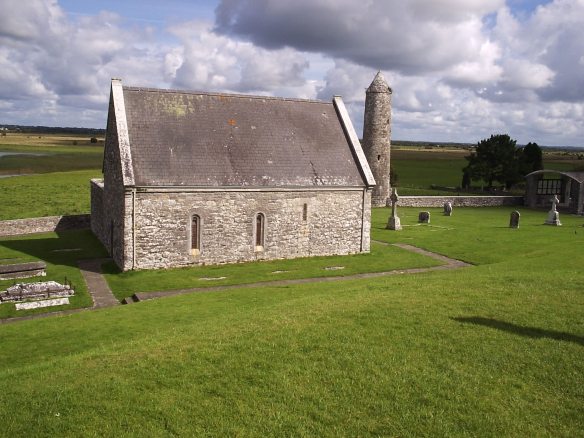
A Peaceful Place with a Violent History
To see it now, Clonmacnoise is the picture of peace and harmony, but its history belies that impression. Despite the humble aspirations of study and worship, life at the monastery was fraught with peril. The settlement was attacked forty times from the 8th to the 12th century and was destroyed thirteen times by fire.
Founded in 545 A.D. by Saint Ciaran, Clonmacnoise was chosen for its ideal location. It borders three provinces, that of Connaught, Munster, and Leinster, and sits at a crucial junction of river and road traffic. As a result, it was once considered the crossroads of Celtic Ireland.
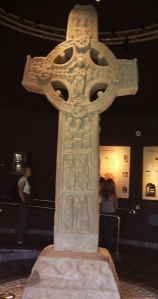
High Cross
Despite modest beginnings, the monastery evolved into an illustrious center of piety and learning that attracted intellectuals from all over Europe. A scholar himself Saint Ciaran would have been proud of the heritage of education and craftsmanship he begat. Artists and scribes toiled to learn skills that would grace the pages of famous illuminated manuscripts like the Book of Kells, and the Book of Durrow. Metalworkers and sculptures produced some of the world’s finest Celtic craftwork. A high cross from 900 A.D. is displayed at the visitor’s center.
Prime Target for Invaders
By the 7th century, thanks to the patronage of a generous King, the monastery was enjoying much wealth and notoriety. This fact made it a formidable power, but also a prime target for invaders. Over the years, the monks fought off both Viking and Anglo-Norman armies and were attacked 26 different times by Irish raiders. Records show that on one occasion, Vikings burned 105 dwellings and sent countless citizens to their graves. The determined inhabitants refused to give up however and stoically rebuilt each time. Finally, an effort to insulate the population and control the violence, construction began on a castle in the year 1214.
By the 14th century, the political climate had changed. Clonmacnoise had lost the patronage of the King and declined in importance. Repeated buffetings had finally taken their toll and the monastery fell into decline. This sad change of fortune is reflected in the words of a bardic poet who unsuccessfully sought aid there:
“I give thanks to the King of Heaven,
to God I give thanks,
for having come to the King of Tuam with whom I am,
from the paupers of Clonmacnoise.”
In 1582 Clonmacnoise was totally devastated by the English garrison from Athlone. The destruction was recorded in this journal:
“There was not left, moreover, a bell – small or large, an image or an altar, or a book or a gem, or even a glass in a window from the wall of the church out, which was not carried off”.
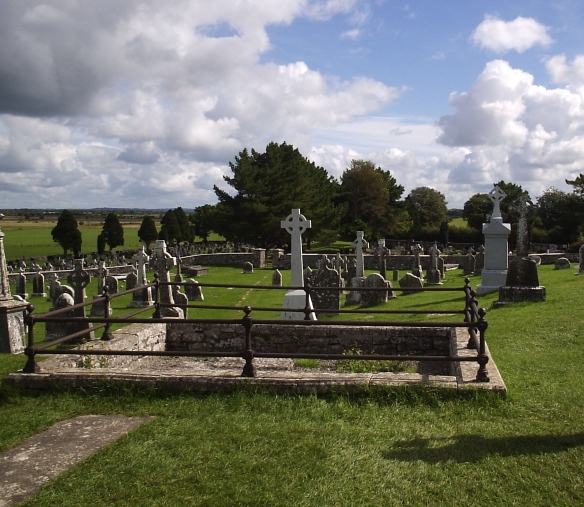
Many Lives Ended Before Their Time
At this point, the settlement was finally abandoned. From the heights of power and influence, Clonmacnoise had fallen to ruin.
In recent years the site has been painstakingly restored and now stands as a monument to its former glory. While the humble ruins we see now, pale in comparison to what once was, in many ways, they are even more compelling.
Ancient Castle Watches Over the Area

As you approach the site today, the first thing you see is the 12th-century castle. Originally a fearsome obstacle to intruders, its bulwarks would have been crowned by sharpened timbers and possibly surrounded by a mote. Age has since reduced the mighty structure to a ghost of its former self, and the shifting ground under its foundation has left the remaining stones with angles that seem to defy gravity. Nevertheless, the castle clings to the hillside in a geriatric attempt to watch over the area it once defended.
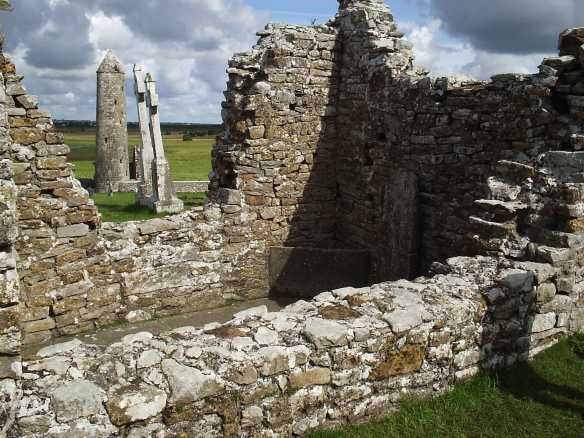
Remains of a Magnificant Monastery
East of the castle is the remains of the monastery. The site includes the ruins of a cathedral, eight churches, two round towers, and three high crosses. One of the small buildings is reputed to be the original church of St Ciaran, and possibly his burial site. Legend has it that if a farmer takes soil from St Ciaran’s church and puts it on the four corners of his own field, he will have good crops. As a result, caretakers have had to keep a watchful eye on the site, or the soil would have been carried away, one bucket at a time.
Another favorite spot is the whispering arch. Once used as a confessional, it is said you can hear clearly through the stone wall. For centuries courting couples have stood on either side of the arch and whispered words of love to each other there. In the cemetery, a large collection of early Christian gravestones tell the stories of former inhabitants. Many stones mark the resting place of entire families – a silent testimonial to the uncertainty of life in the middle-ages, and more specifically, of life at Clonmacnoise.

It’s one place on earth that heaven has kissed, with melody, mirth and meadow and mist.
In spite of, or maybe because of it’s volatile past this site is beloved by the Irish people. Every year in September, large crowds assemble here to celebrate the memory of St. Ciaran. This is also a popular place of pilgrimage, and it’s not hard to see why. In addition to its historic significance, Clonmacnoise is a captivating place, at once tragic and inspiring, and its haunting beauty stays with you long after parting.
If You Go:
Air Lingus offers daily flights to Shannon Airport, departing from Baltimore, Boston, Chicago, Los Angeles, and New York.
Clonmacnoise, Shannonbridge, Athlone, Co. Offaly, Ireland
Clonmacnoise is located 12 miles from both Athlone town and Ballinasloe in County Galway. Daily tours from Athlone to Clonmacnoise can be arranged.
For Irish tourist and lodging information go to www.ireland.ie, or www.irishtourism.com
A good source for self-drive or guided coach tour information is CIE Tours International.

Wow. Awesome.
LikeLike
Pingback: Irish Windows | The Library Lady Travels
Pingback: The Journey Begins | The Library Lady Travels
Pingback: Valldemossa Monastery | The Library Lady Travels
Thanks Paddy. I love your blog.
LikeLike
Paddy, this was a wonderful article. Well done, sir!
LikeLike
I was really flattered to see that Paddy had reposted this on his blog. Glad you liked it. Thanks!
LikeLike
Hi Geanie,
I’ve taken the liberty of re-blogging your excellent post ‘The Haunting Beauty of Clonmacnoise’ again. It is very popular with my readers.
https://irelandtoday.net/2019/07/29/the-haunting-beauty-of-clonmacnoise-by-librarylady/
Thank you.
LikeLike
Reblogged this on IRELAND TODAY .
LikeLike